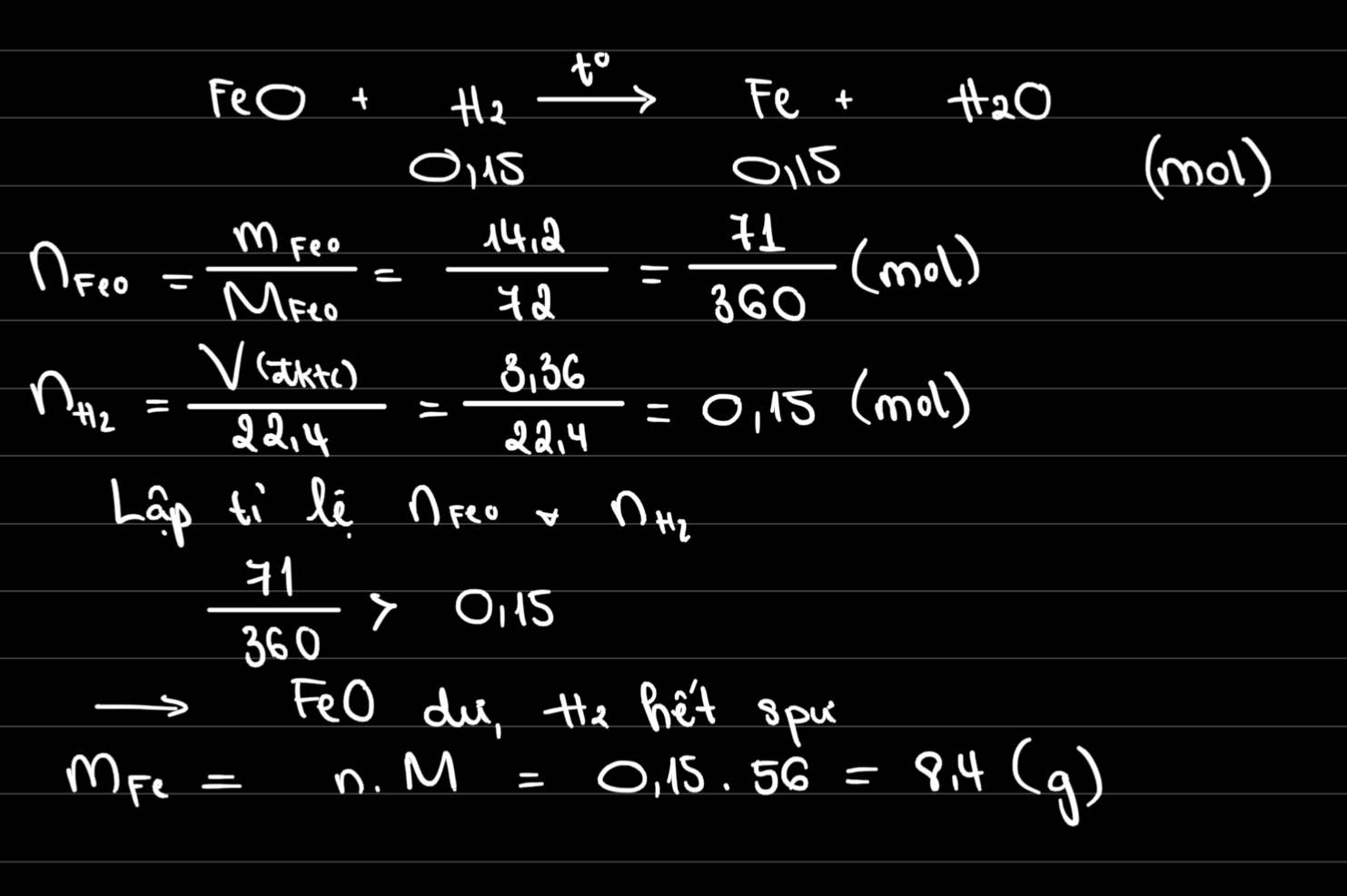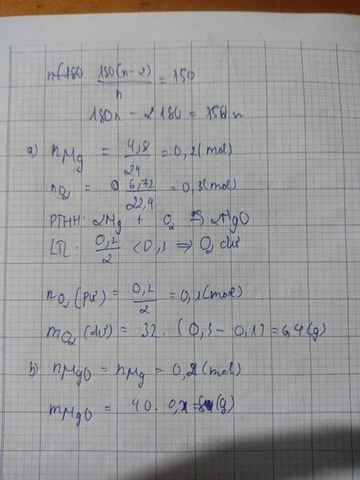Hãy nhập câu hỏi của bạn vào đây, nếu là tài khoản VIP, bạn sẽ được ưu tiên trả lời.

a) Fe3O4 + 4H2 --to--> 3Fe + 4H2O
b)
\(n_{H_2}=\dfrac{2,24}{22,4}=0,1\left(mol\right)\)
\(n_{Fe_3O_4}=\dfrac{23,2}{232}=0,1\left(mol\right)\)
Xét tỉ lệ: \(\dfrac{0,1}{1}>\dfrac{0,1}{4}\) => H2 hết, Fe3O4 dư
PTHH: Fe3O4 + 4H2 --to--> 3Fe + 4H2O
0,025<--0,1------>0,075
=> \(m_{Fe_3O_4\left(dư\right)}=\left(0,1-0,025\right).232=17,4\left(g\right)\)
c) \(m_{Fe}=0,075.56=4,2\left(g\right)\)

Câu 8:
Ta có: \(n_{H_2}=\dfrac{2,24}{22,4}=0,1\left(mol\right)\)
\(n_{O_2}=\dfrac{4,48}{22,4}=0,2\left(mol\right)\)
PT: \(2H_2+O_2\underrightarrow{t^o}2H_2O\)
Xét tỉ lệ: \(\dfrac{0,1}{2}< \dfrac{0,2}{1}\), ta được O2 dư.
Theo PT: \(\left\{{}\begin{matrix}n_{O_2\left(pư\right)}=\dfrac{1}{2}n_{H_2}=0,05\left(mol\right)\\n_{H_2O}=n_{H_2}=0,1\left(mol\right)\end{matrix}\right.\)
\(\Rightarrow n_{O_2\left(dư\right)}=0,15\left(mol\right)\)
\(\Rightarrow V_{O_2\left(dư\right)}=0,15.22,4=3,36\left(l\right)\)
\(m_{H_2O}=0,1.18=1,8\left(g\right)\)
Bạn tham khảo nhé!
Câu 9:
a, PT: \(2R+O_2\underrightarrow{t^o}2RO\)
Theo ĐLBT KL, có: mR + mO2 = mRO
⇒ mO2 = 4,8 (g)
\(\Rightarrow n_{O_2}=\dfrac{4,8}{32}=0,15\left(mol\right)\)
\(\Rightarrow V_{O_2}=0,15.22,4=3,36\left(l\right)\)
b, Theo PT: \(n_R=2n_{O_2}=0,3\left(mol\right)\)
\(\Rightarrow M_R=\dfrac{19,2}{0,3}=64\left(g/mol\right)\)
Vậy: M là đồng (Cu).
Câu 10:
Ta có: mBaCl2 = 200.15% = 30 (g)
a, m dd = 200 + 100 = 300 (g)
\(\Rightarrow C\%_{BaCl_2}=\dfrac{30}{300}.100\%=10\%\)
⇒ Nồng độ dung dịch giảm 5%
b, Ta có: \(C\%_{BaCl_2}=\dfrac{30}{150}.100\%=20\%\)
⇒ Nồng độ dung dịch tăng 5%.
Bạn tham khảo nhé!

`FeO + H_2` $\xrightarrow[]{t^o}$ `Fe + H_2 O`
`a) n_[H_2] = [ 3,36 ] / [ 22,4 ] = 0,15 (mol)`
`n_[FeO] = [ 14,2 ] / 72 = 71 / 360`
Ta có: `[ 0,15 ] / 1 < [ 71 / 360 ] / 1`
`=> FeO` dư
Theo `PTHH` có: `n_[FeO_\text{(p/ứ)}] = n_[H_2] = 0,15 (mol)`
`=> n_[FeO_\text{(dư)}] = 71 / 360 - 0,15 = 17 / 360 (mol)`
_______________________________________________
`b)` Theo `PTHH` có: `n_[Fe] = n_[H_2] = 0,15 (mol)`
`=> m_[Fe] = 0,15 . 56 = 8,4 (g)`

a) n Fe = 5,6/56 = 0,1(mol) ; n HCl = 10,95/36,5 = 0,3(mol)
$Fe + 2HCl \to FeCl_2 + H_2$
Ta thấy :
n Fe / 1 = 0,1 < n HCl / 2 = 0,3/2 = 0,15 nên HCl dư
Theo PTHH : n HCl pư = 2n Fe = 0,2(mol)
Suy ra: m HCl dư = 10,95 - 0,2.36,5 = 3,65(gam)
b)
Theo PTHH : n FeCl2 = n H2 = n Fe = 0,1(mol)
m FeCl2 = 0,1.127 = 12,7 (gam)
m H2 = 0,1.2 = 0,2(gam)
c)
$CuO + H_2 \xrightarrow{t^o} Cu + H_2O$
n Cu = n H2 = 0,1(mol)
m Cu = 0,1.64 = 6,4(gam)

a. \(n_{Mg}=\dfrac{4,8}{24}=0,2\left(mol\right)\)
\(n_{O_2}=\dfrac{6,72}{22,4}=0,3\left(mol\right)\)
PTHH : 2Mg + O2 -> 2MgO
0,2 0,1 0,2
Xét tỉ lệ : \(\dfrac{0,2}{2}< \dfrac{0,3}{1}\) => Mg đủ , O2 dư
\(m_{O_2\left(dư\right)}=\left(0,3-0,1\right).32=6,4\left(g\right)\)
b) \(m_{MgO}=0,2.40=8\left(g\right)\)

a)\(n_{Mg}=\dfrac{35,6}{24}=1,483\left(mol\right)\)
\(V_{O2\left(đktc\right)}=\dfrac{21,504}{22,4}=0,96\left(mol\right)\)
pt: 2Mg + O2 → 2MgO (1)
mol: 2 1 2
mol:1,483 0,96
Tỉ lệ: \(\dfrac{1,483}{2}=0,7415< \dfrac{0,96}{1}=0,96\)
Mg tác dụng hết. O2 dư
theo PTHH có
\(n_{O2p\intư}=\dfrac{1,843x1}{2}=0,7415\left(mol\right)\)
nO2 dư=1,843-0,7415=1,1015 (mol)
mO2dư= 1,1015 x 32 = 35,48 (g)
b)theo PTHH có
\(n_{MgO}=\dfrac{1,843x2}{2}=1,843\left(mol\right)\)
nMgO = 1,843 X 40 = 73,72 (g)
c)
nMg PT(1)=nMgPT(2)=1,843 (mol)
pt: Mg + H2SO4 ➝ MgSO4 + H2 (2)
mol: 1 1 1 1
mol: 1,843
Theo PTHH có
\(n_{H2}=\dfrac{1,843x1}{1}=1,843\) (mol)
mH2=1,843 x 2 = 3,686 (g)

a) PTHH: \(CuO+H_2\underrightarrow{t^o}Cu+H_2O\)
b+c) Ta có: \(n_{H_2}=\dfrac{2,24}{22,4}=0,1\left(mol\right)=n_{CuO}=n_{Cu}\)
\(\Rightarrow\left\{{}\begin{matrix}m_{Cu}=0,1\cdot64=6,4\left(g\right)\\m_{CuO}=80\cdot0,1=8\left(g\right)\end{matrix}\right.\)
d) Ta có: \(n_{CuO}=\dfrac{12}{80}=0,15\left(mol\right)\)
\(\Rightarrow\) CuO còn dư, Hidro p/ứ hết
\(\Rightarrow n_{CuO\left(dư\right)}=0,05\left(mol\right)\) \(\Rightarrow m_{CuO\left(dư\right)}=80\cdot0,05=4\left(g\right)\)




HgO+H2-to>Hg+H2O
0,025-0,025--0,025
n HgO=\(\dfrac{8,68}{217}\)=0,04 mol
n H2=\(\dfrac{0,56}{22,4}\)=0,025 mol
=>HgO dư
=>m Hg=0,025.201=5,025g
nH2 = 0,56/22,4 = 0,025 (mol)
nHgO = 8,68/217 = 0,04 (mol)
PTHH: HgO + H2 -> (t°) Hg + H2O
LTL: 0,025 < 0,04 => H2 dư
nH2 (p/ư) = nHg = 0,025 (mol)
VH2 = (0,04 - 0,025) . 22,4 = 0,336 (l)
mHg = 0,025 . 201 = 5,025 (g)